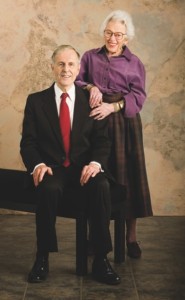
About the Scholars Program
The Quilt Alliance established the Ardis James QSOS Scholars Program in 2013 with the support of the Robert and Ardis James Foundation to support research that draws on the rich resource of over 1,200 Quilters’ S.O.S. – Save Our Stories (QSOS) interviews collected by the Alliance since 1999. Scholars use the QSOS archive to produce original research to disseminate as essays, exhibitions, curricular materials, and interactive content.
QSOS interviewees share how quilting impacts their lives, including inspiration found in unlikely places, comfort during times of grief, and joyful artistic collaboration among friends. Our interview archive is a valuable resource for anyone interested in quilts and quiltmakers, as well as craft, folk art, and the process of making things. It’s our hope that the Ardis James QSOS Scholars Program will enable scholars to dig into the archive and investigate those stories, making connections among interviews, finding common themes, placing histories in context, and spotlighting incredible moments.
About Ardis James
Ardis Maree Butler (December 5, 1925 – July 7, 2011) was born in Lincoln, Nebraska, and raised in Lincoln and Omaha. She married Robert G. James of Ord, Nebraska, in 1949, and they raised three children: Robert Jr., Catherine, and Ralph. They made their home in Chappaqua, New York.
Ardis James, expressed her lifelong love for fabric and needlework in her own quiltmaking, ownership of a fabric store, and most significantly, in the quilt collection she and Robert built together. Their large and important collection became the founding donation that sparked the establishment of the International Quilt Study Center at the University of Nebraska-Lincoln in 1997.
Ardis and Robert James were among the first to collect the work of contemporary studio artists who began, in the late 1970s, to make nontraditional quilts as works of art. Pauline Burbidge, a UK studio quilt artist, expressed the impact of their support: “This recognition meant a great deal to me and has helped give me the confidence and drive to continue with my quiltmaking career.” Linda MacDonald, another studio quilt artist, noted regarding Ardis: “Her inclusive love for diverse quilt forms was very inspiring.”
You can learn more about Ardis and her husband Robert on this Quilt Treasures mini-documentary. Quilt Treasures is a partner project of the Quilt Alliance, Michigan State University Museums, and MATRIX: The Center for Digital Humanities and Social Sciences at Michigan State University.
Call for Proposals – Fall 2023 – Currently closed
The Quilt Alliance is seeking proposals for the 2023 – 2024 Ardis James QSOS Scholars program, which funds educational and creative work that makes use of its archive of more than 1,200 recorded oral histories with quiltmakers.
The program is open to researchers, artists, students, historians, folklorists, and any other quilt enthusiasts who will use the interviews in the QSOS (Quilters’ Save Our Stories) oral history project archive to inform new work. This may include essays, audio pieces, exhibitions, textile art, multimedia presentations, interactive content, creative writing, and more.
QSOS interviewees share how quilting impacts their lives, including inspiration found in unlikely places, comfort during times of grief, and joyful artistic collaboration among friends. Our interview archive is a valuable resource for anyone interested in quilts and quiltmakers, as well as craft, folk art, and the process of making things. It’s our hope that the Ardis James QSOS Scholars Program will enable scholars to dig into the archive and investigate those stories, making connections among interviews, finding common themes, placing histories in context, and spotlighting incredible moments.
The Quilt Alliance will select two scholars for the 2024 program. Scholars will be expected to produce a piece to be presented on the Quilt Alliance website, and to share their work in an online Textile Talk presentation in 2024. Each scholar will receive a $1,000 honorarium.
About QSOS
Quilters’ Save Our Stories (QSOS) is an oral history project started in 1999 by the Quilt Alliance. It contains more than 1,200 interviews with quiltmakers, predominantly from the United States but also living around the world. Each interview is audio recorded, and includes at least two photographs of the quilter and one of their quilts. Currently, a project is underway to migrate the full collection to a new website where each interview can be heard in its entirety, along with an interview index that highlights themes and keywords. Migrated interviews can be seen at: qsos.quiltalliance.org and scholars will be provided with training on searching the full collection.
Interviews are wide-ranging and include topics such as: learning to quilt, quiltmaking techniques, social and community aspects of quiltmaking, the economics of quiltmaking, the importance of quilts to womens’ history and American life, politics and activism, grief and healing, and the creative process.
Additional project details
The form of the final research project is flexible, but will consist of two parts:
1. A piece that will be shared via the Quilt Alliance website
The final project will live on the Quilt Alliance website with past Ardis James QSOS project pieces. The form of this piece is flexible, and may include a written piece, audio works, physical artwork with photo documentation and a written reflection, or other form that can be shared online.
2. A virtual presentation about the project during the Textile Talks lecture series
Textile Talks are Wednesdays at 2 pm Eastern, but specific lecture dates will be scheduled with each scholar. Textile Talks presentations are approximately 40-45 minutes.
Projects should make use of at least three different QSOS interviews (unless a project is proposed that focuses deeply on a single interview), but can include additional sources as desired. Use of the audio recordings and other multi-media work is especially encouraged.
Application process
All applications should be submitted via this form. Applicants should include:
- a resume/CV (2 pages maximum)
- a short proposal (350 words or less) that outlines your proposed project, including the format of your project, themes or topics it might address, and, any existing QSOS interviews that are of particular interest to you
Questions? Contact qsos@quiltalliance.org
Meet the 2024 Ardis James QSOS Scholars
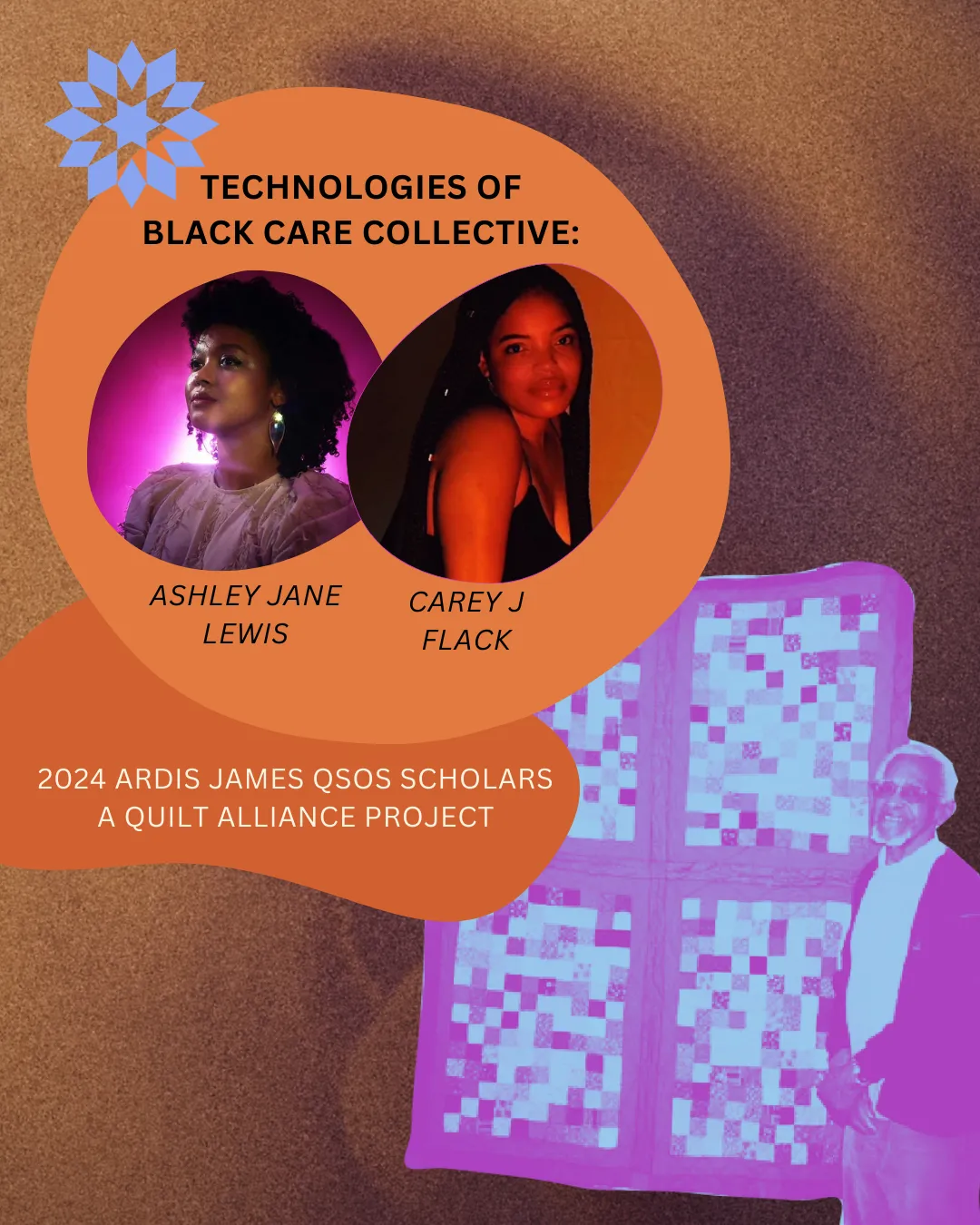
The Technologies of Black Care Collective will host MEMORY PATTERN, a collaborative 4 week quilting project in tribute to Black textile communities of the past, present and future. Facilitated by artist, archivist and speculative design duo Ashley Jane Lewis and Carey J Flack, 30 selected participants will meet weekly on Zoom to co-create a cross-national quilt while ruminating on the oral and written history of Daughters of Dorcas, the oldest Black quilt guild in North America.
MEMORY PATTERN will draw especially on excerpts from the 2002 QSOS interview with Viola Williams Canady.
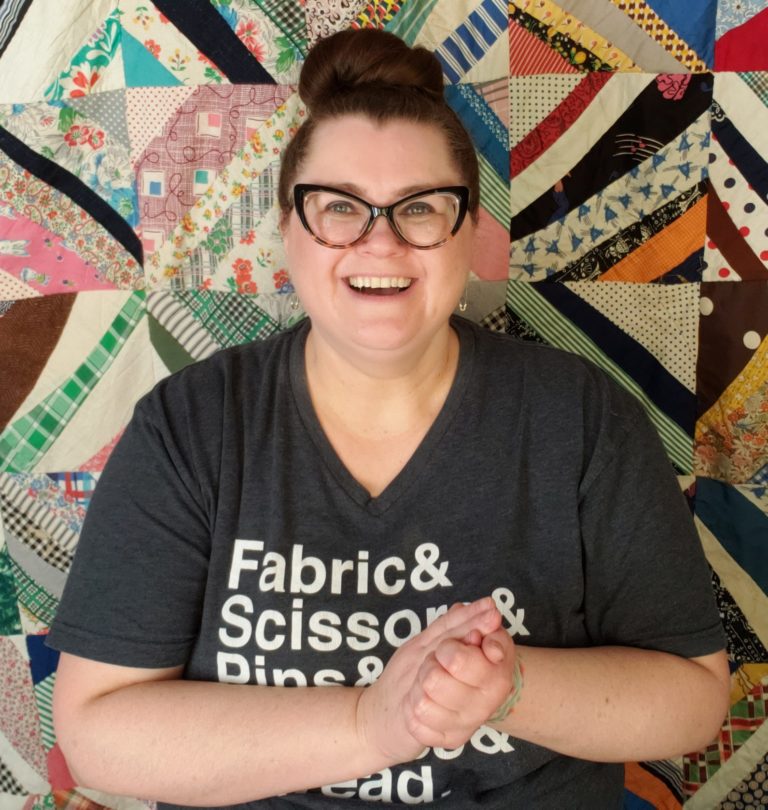
Stephanie Capps Dyke
Stephanie’s proposed project dovetails with her recent work studying Dr. William Rush Dunton Jr.’s quilt collection, and use of handcraft as occupational therapy for his mentally ill patients in the early- and mid-1900s. She will create a 3-dimensional, multimedia, quilted piece which will utilize snippets of the QSOS interviews, as well as other collected interviews. The goal of the artwork and its accompanying media will be to highlight the effectiveness of handwork in managing mental and emotional health, as well as educating and inspiring current and future needleworkers.
Stephanie’s project will use QSOS excerpts focused on how quilting helps interviewees through difficult times, such as illness or grief.
Look for more about both projects coming soon. The 2024 Scholars will present their work online and at a free Textile Talk this July – stay tuned for more details. We can’t wait to hear how these projects develop, and look forward to sharing this work with you all soon!
Meet the 2022 Ardis James QSOS Scholars
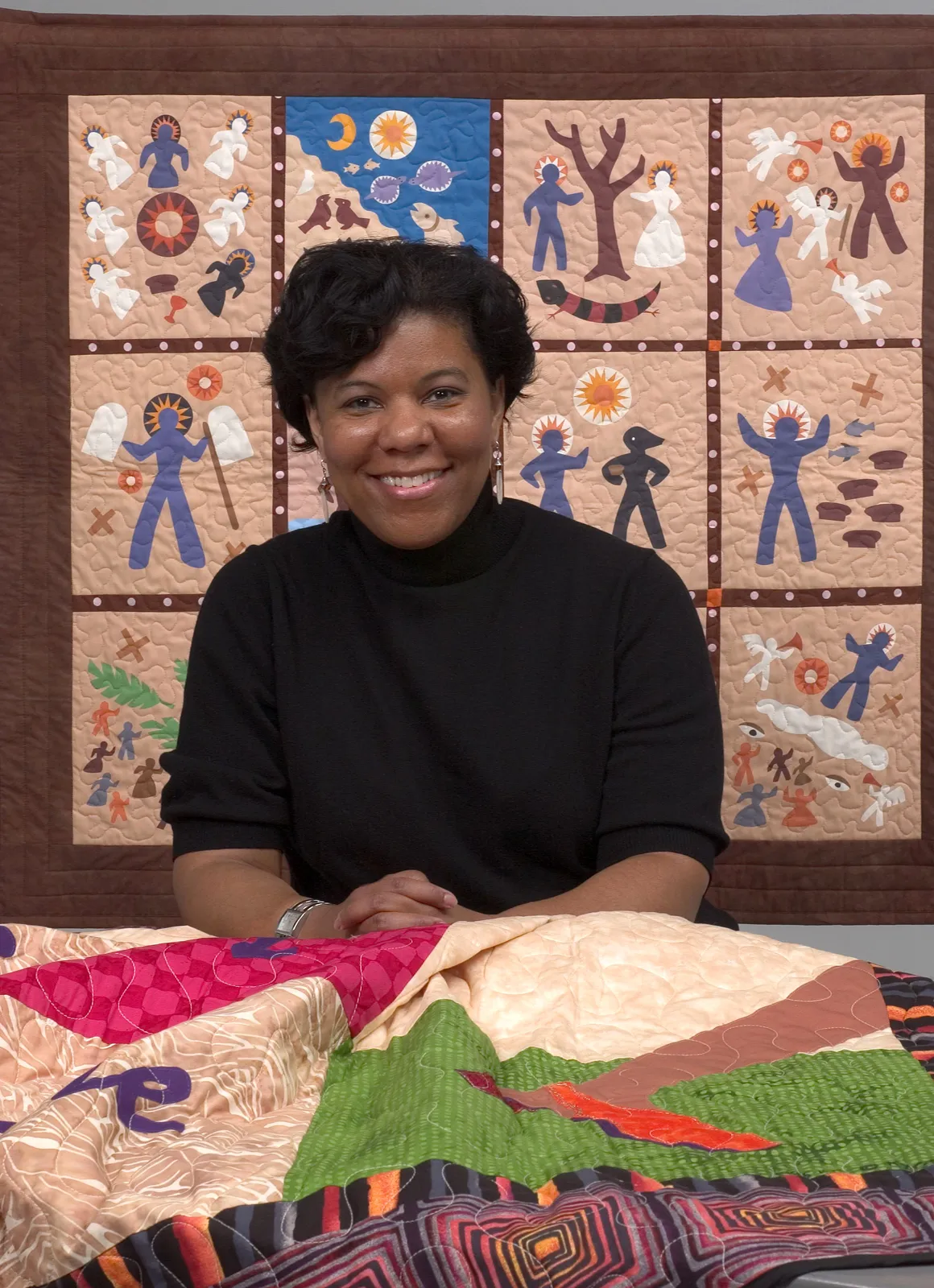
Kyra E. Hicks is a self-taught, skilled crafter of original story quilts. Her quilts have been included in such prestigious venues as the American Craft Museum in New York, the Smithsonian Institution’s Renwick Gallery in Washington DC, and the Wadsworth Atheneum in Hartford. She loves historical, investigative research and rediscovering the lives of quilters past. She is the author of Black Threads: An African American Quilting Sourcebook, the children’s book Martha Ann’s Quilt for Queen Victoria, and This I Accomplish: Harriet Powers’ Bible Quilt and Other Pieces and other books. She lives in Arlington, VA.
Visit Kyra online at www.blackthreads.com
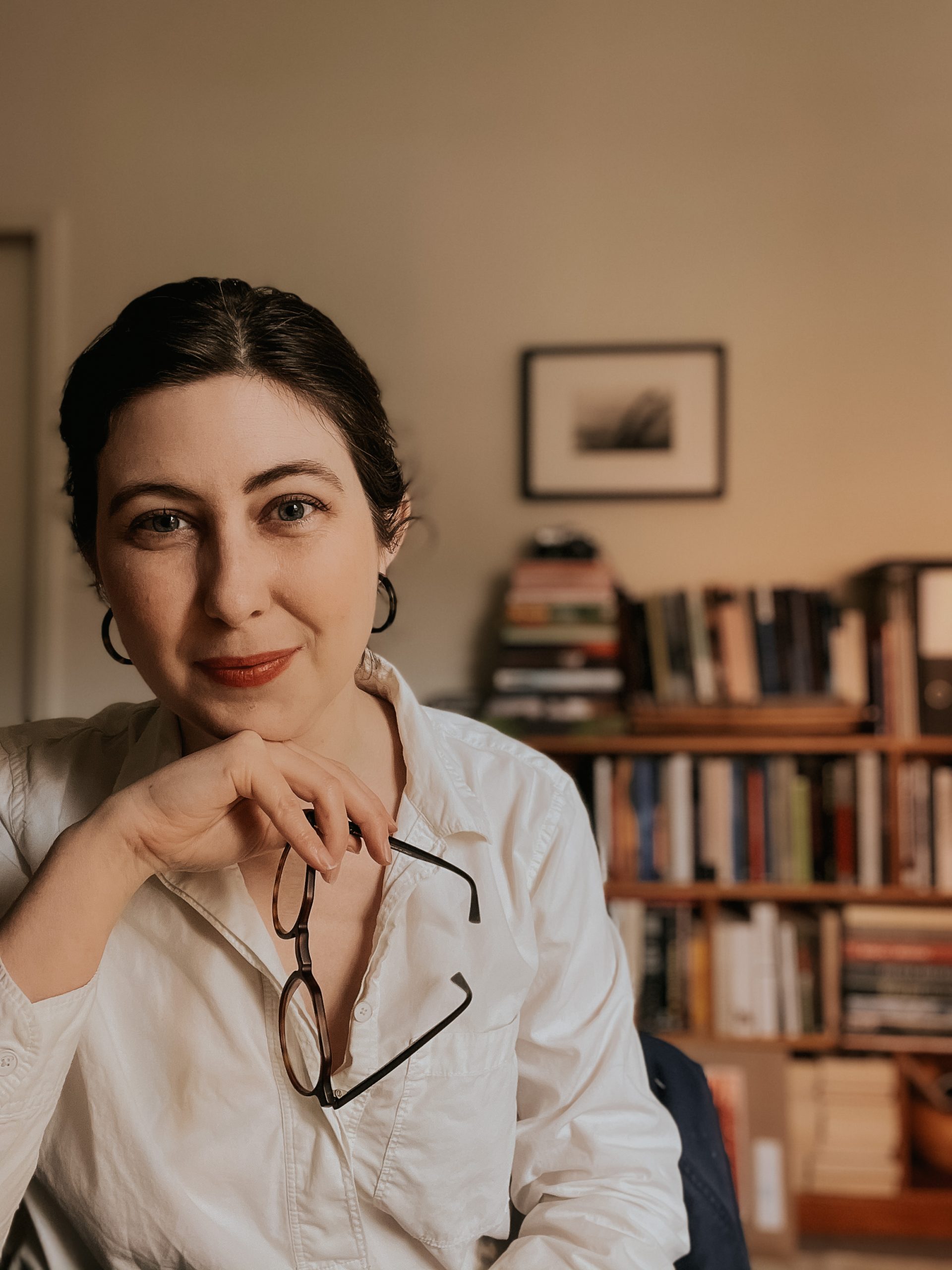
Jess Bailey
The art historian and quilter behind Public Library Quilts (@publiclibraryquilts), Jess Bailey (she/her) believes knowing where art comes from has the power to shift present structures of harm. Jess is the author of Many Hands Make a Quilt: Short Histories of Radical Quilting from Common Threads Press, 2021. Currently finishing her PhD in the History of Art department at the University of California at Berkeley, she is based in London, UK as a research fellow. Jess’ academic writing addresses the relationship between state violence and interpersonal violence in European art before the 16th century. She is the co-founder of the LION Quilt project with gardener Sui Searle, @DecoloniseTheGarden, and the primary quilter of the resulting plant dyed Land in Our Names Quilt which raised over 18k GBP (25k USD) in Spring 2021 for the land and racial justice work of @LandInOurNames.
Make a Zine Inpired by QSOS Projects
by Kyra E. Hicks
I’m a quilter like you. I enjoy piecing, appliqué and telling stories through fabric. However, I’m not an artist, per se, so I’m always surprised by seeing my stick figures become recognizable images when I make story quilts. I also enjoy self-publishing.
I’m thrilled to share ideas for combining these things I enjoy – being a quilter, sharing stories, and self-publishing – through the medium of a zine.
What is a zine?
According to Wikipedia, “a zine is a small-circulation self-published work of original or appropriated texts and images, usually reproduced via a copy machine.”
Zines are typically very affordable, sometimes just a dollar or so. Zinesters are passionate about creating, collecting and trading zines. Topics can focus on ANYTHING.
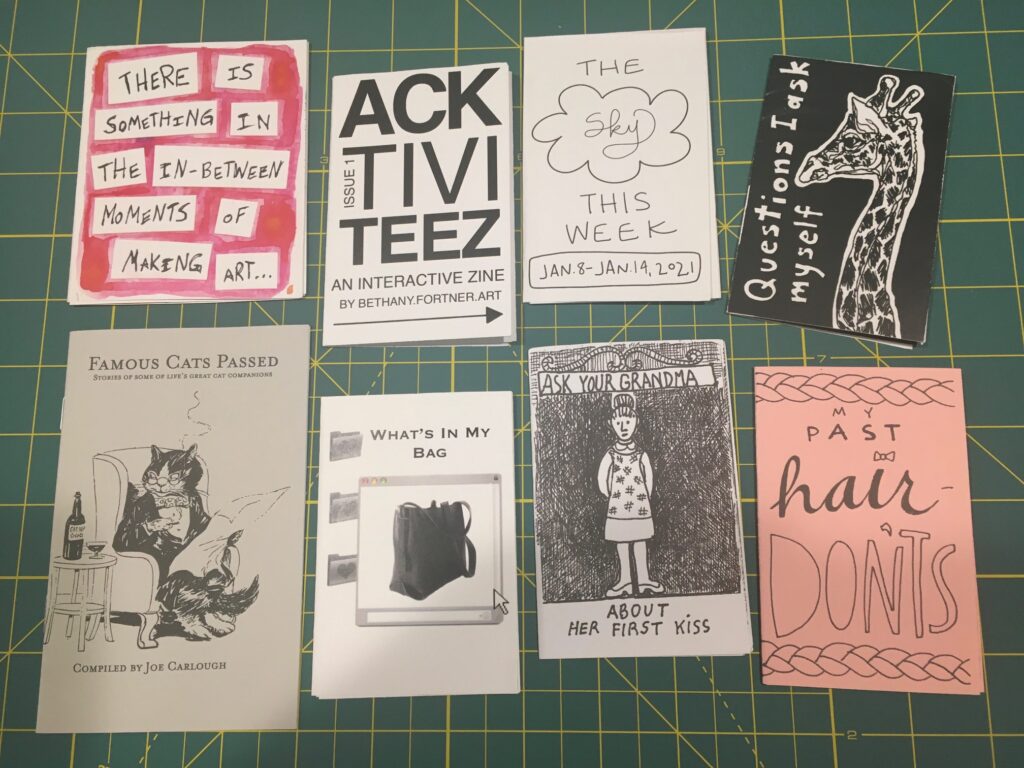
Zines I read in the last month.
As a quilter, I look for zines related to quilters, quilting, sewing, stitching and fabrics. A few years ago, the National Museum of Women in the Arts in Washington, D.C., hosted a book arts fair. I met librarian and artist Jamila Zahra Felton and purchased her zine How I Felt #1 (2015), a zine about self-empowerment. The zine materials included typed text or copy that was cut and pasted onto various printed backgrounds. The 16 pages were photocopied, cut to size and stapled between a felt cover.
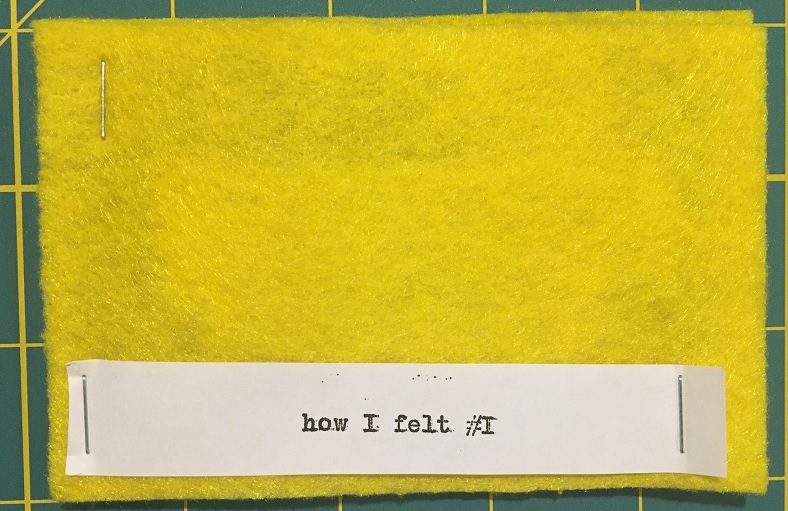
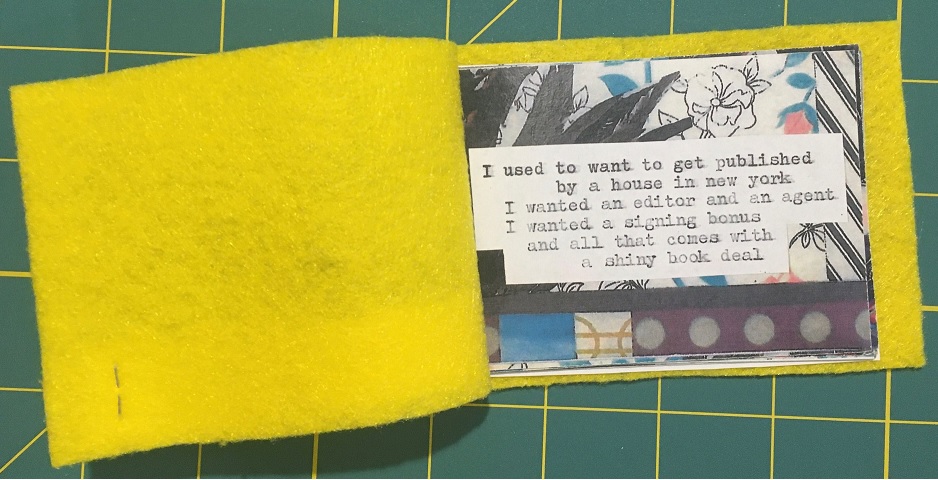
How I Felt #1 by Jamila Felton (cover) How I Felt #1 by Jamila Felton (interior)
Zak Foster, Laura Loewen, Heidi Parkes and others have created quilting-related zines.
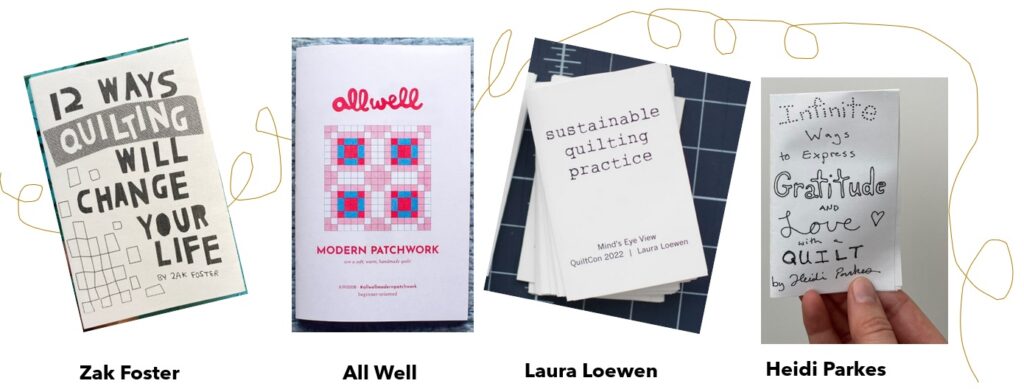
You can also check-out zines from your local library. Barnard College of Columbia University in New York City, which has more than 6,500 zines in its Barnard Zine Library, hosts an online directory of libraries worldwide with zine collections.
Let’s use QSOS interviews for zine inspiration!
Quilt Alliance has led the Quilters’ S.O.S. – Save Our Stories (QSOS) project since 1999. The goal is to interview quilters and preserve their oral history about quilt-making for generations to come. To date, there are ~1,200 interviews.
The database of QSOS interviews is in the process of being moved to a new website. As a result, one can access the interviews at: http://qsos.quiltalliance.org/ or using the Internet Wayback Machine at Quilt Alliance (archive.org). In addition, you can browse the database by interviewee or quilter, location or quilt project. The database includes interviews with quilters involved in 90 different projects and guilds.
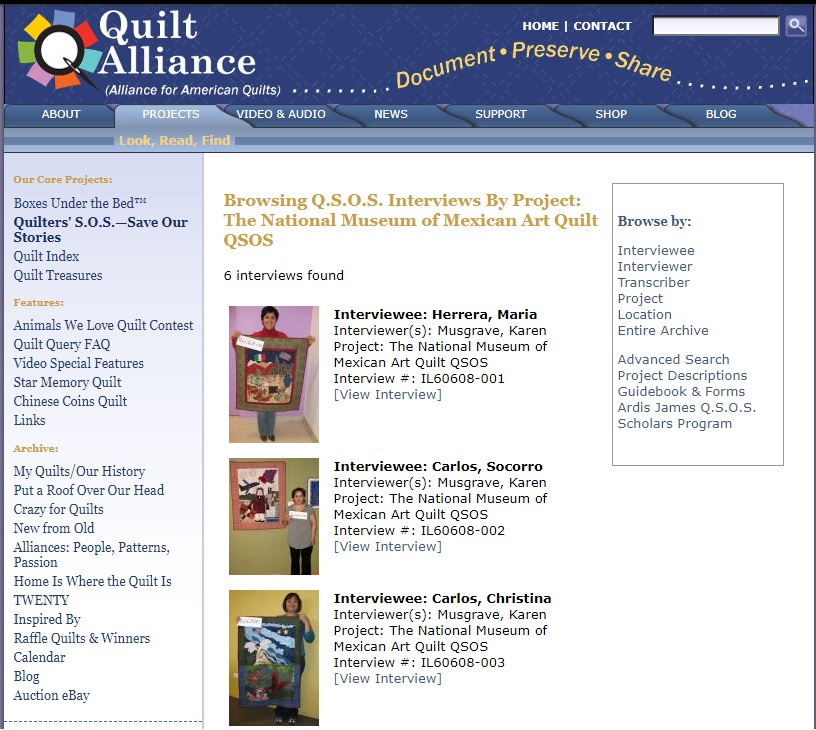 Quilt Alliance website on the Internet Wayback Machine, accessed July 22, 2022.
Quilt Alliance website on the Internet Wayback Machine, accessed July 22, 2022.
QSOS zine ideas
Each QSOS interview includes a photograph of the quilter, his/her/their quilt, and the interview transcript. You might consider making a zine based on the following theme:
- Stitching with Mary. You can profile quilters named Mary. There are over 40 in the QSOS database. Or you can have fun by searching for other names.
- Quilters from Michigan – or your favorite state or hometown.
- Project highlights. Focus on one of the 90 projects listed in the database, including the Alzheimer’s Forgetting Piece by Piece exhibition.
- Patterns. Showcase photos of quilts using a specific design, like star blocks or cat quilts, in your zine.
- Quilter quotes or sentiments. The QSOS interviews are rich with insights. For example, you might create a zine with quotes about “my first quilt”, “on being a fabric-holic”, or quilt-making as a superpower.
Zine from a single sheet of paper
One of the easiest ways to make a zine is to use a single sheet of paper. You’ll need to fold the paper into eight sections (see yellow lines in photo below), make one cut, refold and create an eight-page zine including the front and back covers. Notice that pages 1-4 are oriented in the opposite direction of pages 5-8. Therefore, when the zine is folded, all the text will have the same orientation.
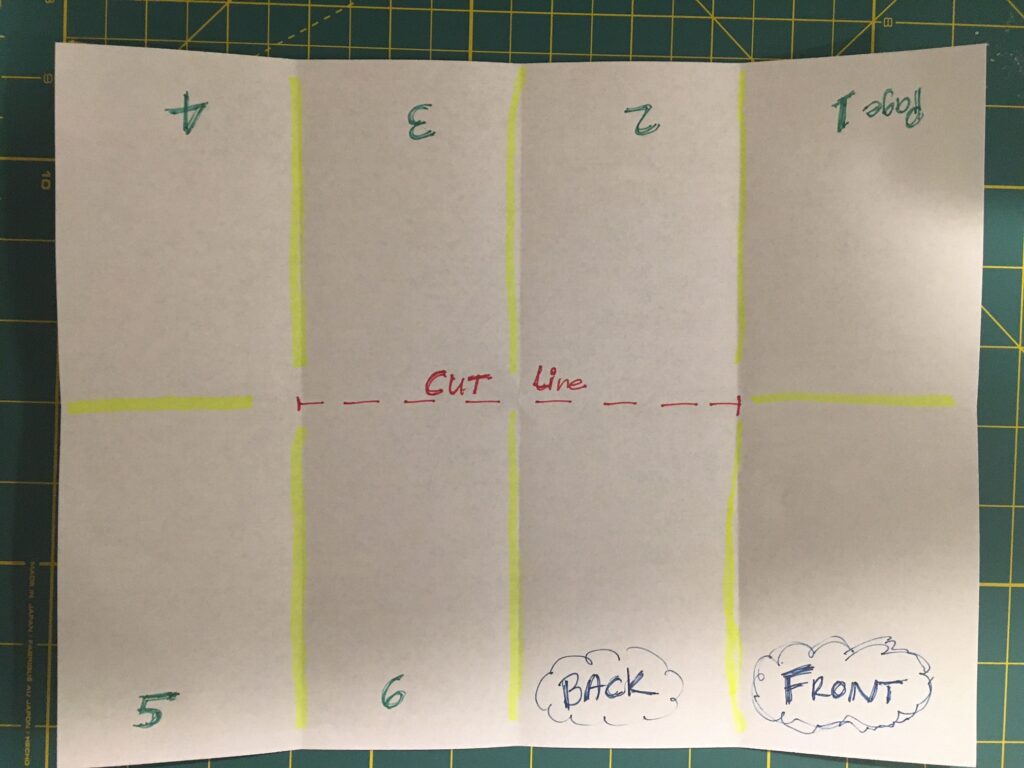
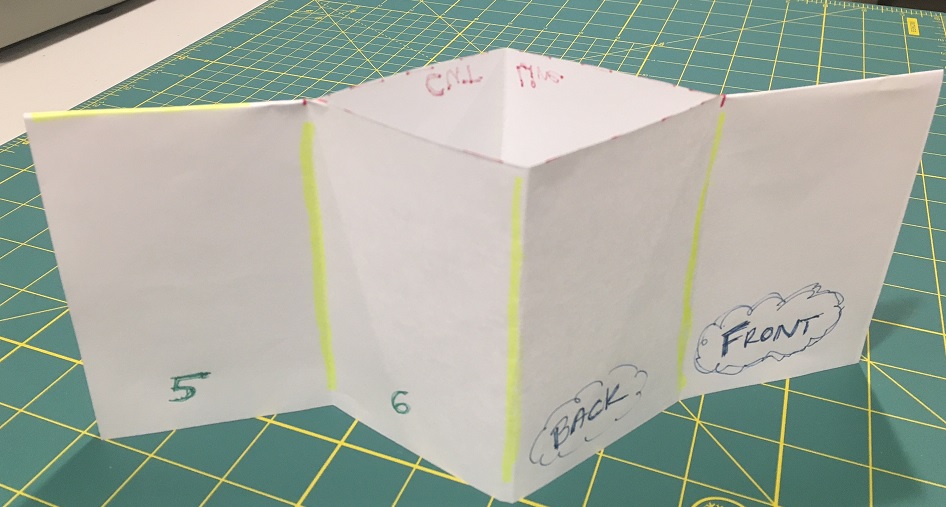
Here are two short YouTube videos to show you how to fold your paper:
- Folding an instant book, zine, or one-page book by Heidi Parkes (1:38 mins)
- How to make a zine from one piece of printer paper by Dilon Pilorget (3:10 mins)
Now, I can’t draw more than stick figures. But I can use Microsoft Word to insert images and text to create a zine using a single piece of paper.
I made a zine about the steps to make a story quilt. Below is the single sheet pattern. I used Microsoft Word to ensure the copy on pages 1-4 is in the opposite direction as pages 5-8. From the main menu, click Insert > Text Box and place the text box in one of the pages. Next, type your copy or insert an image. Add new text boxes as needed. You can turn the text box upside down using the curved arrow at the top of the text box. The heavy lines here are to illustrate the page folds. Cut along the dotted line.
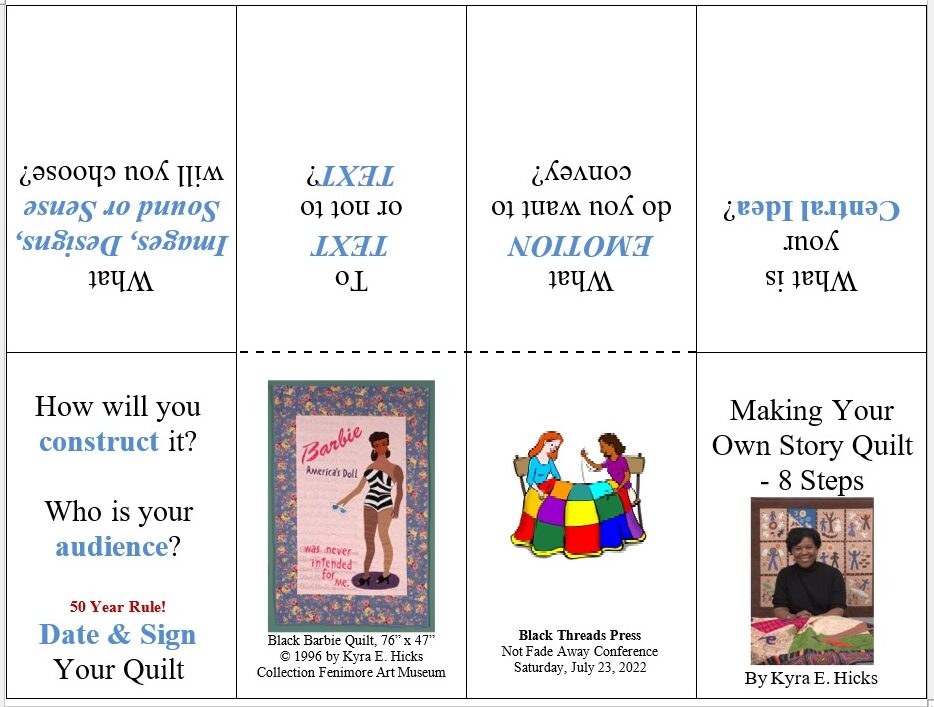 Making Your Own Story Quilt – 8 Steps zine by Kyra E. Hicks (2022).
Making Your Own Story Quilt – 8 Steps zine by Kyra E. Hicks (2022).
From QSOS to a zine: one example
In May 2022, Washington, DC-based zinester Ira Golthi took on the challenge to create a zine inspired by the Quilters’ S.O.S. – Save Our Stories interviews. She neither owns a quilt nor is a quilt maker. However, Ira “…became excited drawing parallels between quilting, a craft that is viewed as traditional and maybe even conservative, and zine making, which is typically associated with left-leaning radical views and fringe political opinions.“
Ira drew inspiration from five different QSOS interviews.
- Coulter Fussell (2021)
- Toni Baumgard (2000)
- Norma Storm (1/20)
- Marlene Peterman (2002)
- Marjorie Digg Freeman (2009)
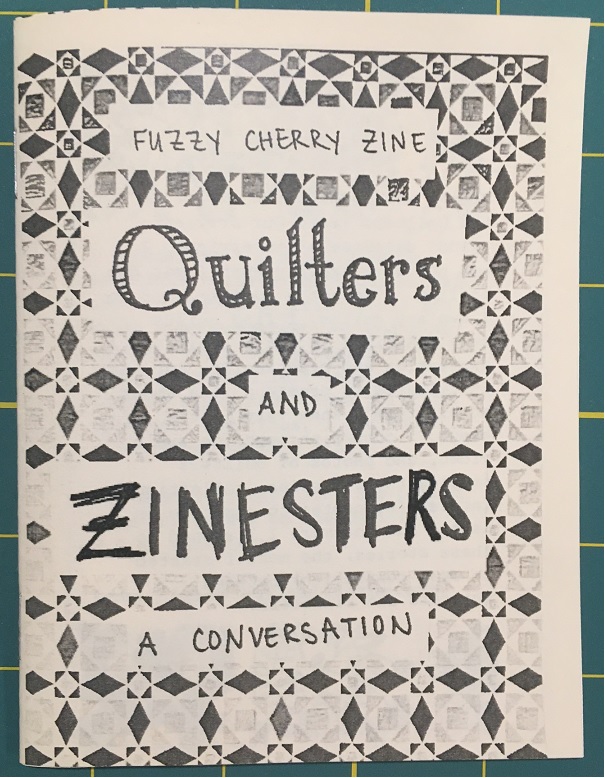
Quilters and Zinesters: A Conversation (2022) by Ira Golthi of Fuzzy Cherry Zine.
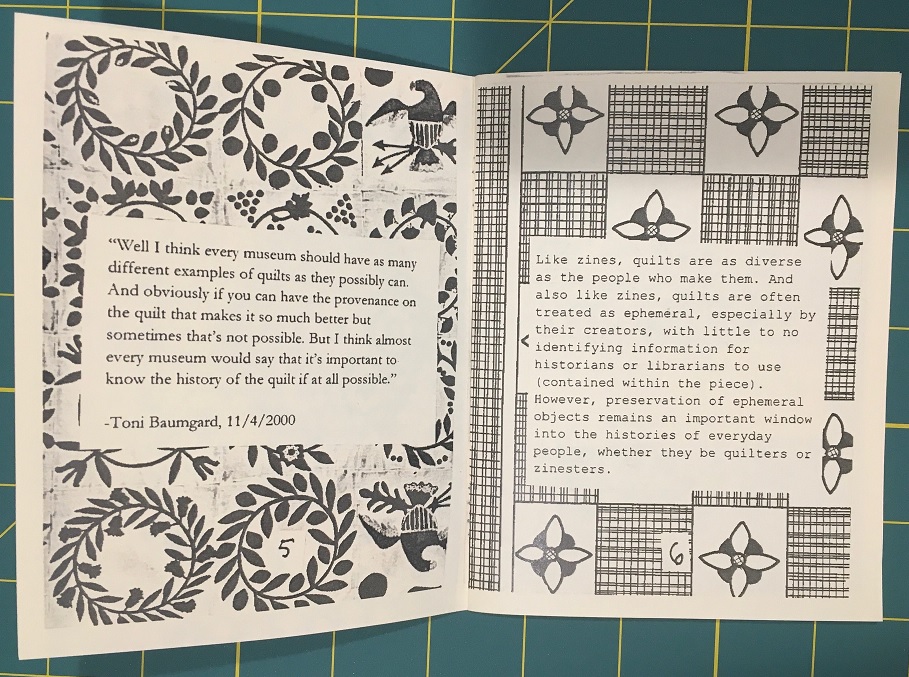
Quilters and Zinesters: A Conversation (2022) by Ira Golthi of Fuzzy Cherry Zine. Interior Pages.
Share your zine
Once you have created a zine inspired by QSOS, consider donating a copy to the Quilt Alliance and the Library of Congress.
Incarceration Quilts: Stitching Wire in the Ohio Reformatory For Women
by Jess Bailey
Hello quilters and researchers,
My name is Dr. Jess Bailey (@publiclibraryquilts) and I was fortunate to be a 2022 Ardis James Quilt Scholar. While my research into the oral history archive is ongoing with plans for publication in a volume edited by Dr. Sharbreon Plummer, I’d like to share one very special quilt with you today. I am an art historian and quilter interested in the diverse ways quilts archive history. You can read more of my writing on quilts in my zine Many Hands Make a Quilt: short histories of radical quilting from Common Threads Press.
As an art historian, I am familiar with researching artworks made by anonymous artists who either didn’t leave behind an archive of information about their work or who were not included in normative archives. One of the many benefits to a truly grassroots archive project like the Quilt Alliance’s oral history work is that stories and voices not necessarily celebrated or recognised as important by the art world at large can be recovered. These voices productively challenge how we define who gets to be an artist and a quilter.
I have been working with a very compelling and challenging set of interviews preserved by the Quilt Alliance, interviews from quilters in the Ohio Reformatory for Women. Let’s look at one of the quilts connected to these interviews. This is a photo of Rosa Angulo’s first quilt.
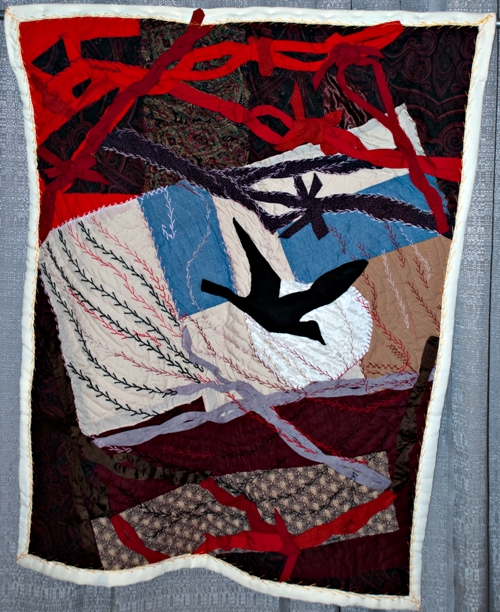 A black bird in flight charts a safe path through Rosa’s vibrant and commanding quilt. A soft surface replete with stitched images of hard and sharp things. Above this bird, thick appliquéd barbed wire recalls human arteries. The red cloth pulsates the longer you look at it. The quilter has used two distinct tones of scarlet fabric to create these undulating, spiky lines.
A black bird in flight charts a safe path through Rosa’s vibrant and commanding quilt. A soft surface replete with stitched images of hard and sharp things. Above this bird, thick appliquéd barbed wire recalls human arteries. The red cloth pulsates the longer you look at it. The quilter has used two distinct tones of scarlet fabric to create these undulating, spiky lines.
One is luminescent, a satin ribbon that catches the light while the other is a deep, blood maroon. In overlapping on the surface of the quilt, these fabrics create a distinct sensation of visual depth. There is a vast world within this quilt. Rosa’s smart and subtle deployment of colour in the upper registers of her quilt is matched across the cascading surface by her understanding of texture and composition. To make an effectively chaotic visual composition, the artist must have the confidence of the black bird charting its precise path. Layering, adding, taking away just enough to give our eye somewhere to rest.
The center of this quilt contains more light fabric than its foreground or background: an almost rectangular patchwork section comprised of creams, blues, and a single patch of soft brown feels like a skylight. In looking down at the quilt across our laps we might imagine we are actually looking up: turning the world on its head and exiting the dark, quiet cavern of barbed wire to emerge into the blue and cream patchwork sky above.
Looking more closely at the patchwork around this bright centre, we see it is not actually monochrome. The colours that appear at first to be black are actually warm rusty browns and reds, some richly patterned and textured fabrics that immediately look soft. These feel no less intentional for being found materials, collected from what was available.
Across this alternatively light and dark quilt top are an incredible array of top stitching lines. First there are the subtle hand quilting lines which are hard to see in photographs. But added to the quilt’s surface are more visible lines, stitched in many colours. These reference Crazy quilt traditions dating back to the late 19th century where the embroidery follows the jagged patchwork of the quilt to visually adorn the different irregular pieces of patchwork. This visual effect always reminds me of surgery, as if the layers of the crazy quilt are being sutured together, the added stitching visually conjoining two distinct areas of cloth. The thread assures us that they will continue to touch, that the patchwork is enduring – through a kind of tender attention of needle and hand. 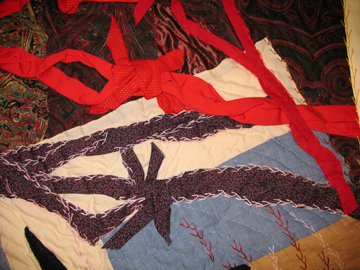
Rosa has followed crazy quilt tradition in some parts of her artwork. However, in other areas of the quilt, the colourful top stitching crosses over the patchwork rather than adhering to its aligned edges. These organic and coiling lines of thread simultaneously recall barbed wire and growing vines. They move across the quilt’s surface as if a wind has detached the sewn wires from a nearby fence. The wire does not seem to contain anything or anyone anymore, but rather float, dismantled into stray strands that cross our vision. We see the ends of some wires, and in this visual stoppage is a kind of possibility. Maybe the wire doesn’t go on forever.
This movement, this chaos, this energy of bird and blood vessels and razor wire and a patch of elusive sky is supported by the uneven shape of the quilt itself. Rather than square off the quilt to a perfect rectangle, Rosa has folded over the white backing to form a thick edge and let the quilt take on the natural curves and puckers of thick fabrics. Rather than forcing the internal composition to conform to perfectly square corners, the movement and dynamism of the quilt is continued through its outer most edges.
This quilt was made in a highly regulated space, a women’s prison in Ohio made of hard and sharp things. Concrete. Wire. Metal fencing. In an act of patience and resistance, this quilt deploys visual disorder to represent hope. Hope, Rosa tells her Quilt Alliance QSOS interviewer is the title she has given this, her very first quilt. In the late 2000s, a quilter and researcher named Karen Musgrave conducted interviews with Rosa and five other incarcerated quilters. The transcriptions of these interviews offer us a unique opportunity to engage with marginalised quilters working in an artistic medium that we all know is synonymous with comfort, home, & healing. Quilts are good at helping us hold trauma or processes pain.
These interviews were unusual at the time they were recorded and remain so today. It is not easy to create quilting opportunities in US prisons and ample social stigma remains about incarcerated people and what opportunities for care are essential for any human life. But the history of quilting is replete with examples of incarcerated people creating quilts and quilters agitating for abolition against the systemic abuses of the prison industrial complex.
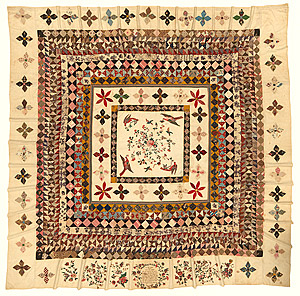
The Rajah quilt, by unidentified women of the convict ship “HMS Rajah”, c. 1841
For example, in the early 19th century English prison reformer Elizabeth Fry advocated for humane living conditions. Fry argued that incarcerated women should be given applicable job training while in prison. A group of women associated with her work produced an incredible quilt known as the Raja Quilt in 1841. The Q.S.O.S. archive interviews are not unrelated to this important historical record of quilting & incarceration, in fact they are simply the next unwritten chapter.
Alongside the QSOS interviews we have records detailing a Sacred Threads exhibition which showcased the Ohio Reformatory women’s quilts in the later 2000s. Artist statements from this exhibit help us understand the quilts and quilters better and also offer a space of verbal expression apart from the direct prison context. In speaking with Karen, who stayed in touch with the women after the interviews, I have learned that some of the quilts made it to family members and Karen herself was able to give a quilt that she made to one of the women upon her release.
But back to Rosa and her quilt, Hope.
I would like to share with you an audio clip from Rosa’s interview and her answers to a few of the Q.S.O.S. questions. For context, Rosa has began her interview telling us about her challenges with drug addiction. When you listen to this you will hear Rosa reference an image she has seen in a magazine of a quilt, I think it’s pretty clear that she has been inspired by the style of a pictured quilt and that her quilt composition is her own design. In the transcript we learn that she is pointing to something specific in her quilt when she mentions the inspiring magazine. Rosa is from Mexico and thus it is perhaps unlikely that as a first-time quilter she was deeply familiar with the very American crazy quilt style. Listen out for her mention of Sacred Threads in the interview and why being included in QSOS is important to her:
There is no better ambassador for quilts and their stories than quilters themselves. I think this is something that makes the QSOS archive incredibly special. I can use the skills I have as an art historian and quilter to comment on Rosa’s work, to try to tell you why it matters and what it means. But my authority as an audience member will never be more important than her authority and knowledge of her own work as the quilter and in the QSOS archive I can actually listen to what she thinks and feels about her quilt.
I was particularly moved by Rosa’s description of quilting which captures the humour of all of us cutting fabric apart to put it back together again along with the power of quilting as an art form, of course. Rosa: “Before I thought it was just pieces – ripping them apart and putting them back together. But I find out that it is really an art.” The last remark in this clip has been ringing in my ears since I first heard it. Rosa tells us that her quilt means that her daughter will now be able to really see her.
As my research into this area of the quilt archive continues, I am asking if anyone with information about the quilting in the Ohio Reformatory or specifically about Rosa Angulo would contact me at publiclibraryquilts@gmail.com. The last record we have of Rosa is of her immediate deportation to Mexico upon release from the Ohio Reformatory.
Past Ardis James Q.S.O.S. Scholars
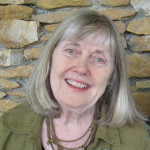 Barbara Brackman, quilt historian, curator and teacher. Barbara is the author of a number of books about quiltmaking and quilt history including the Encyclopedia of Pieced Quilt Patterns and Clues in the Calico: A Guide to Identifying and Dating Antique Quilts and was inducted into the Quilters Hall of Fame in 2001.
Barbara Brackman, quilt historian, curator and teacher. Barbara is the author of a number of books about quiltmaking and quilt history including the Encyclopedia of Pieced Quilt Patterns and Clues in the Calico: A Guide to Identifying and Dating Antique Quilts and was inducted into the Quilters Hall of Fame in 2001.
View Barbara’s project: Tradition and Aesthetics in QSOS Interviews
 Christine Humphrey earned her doctorate and master’s degree from the University of Nebraska-Lincoln where she specialized in textile history with a quilt studies emphasis. Her scholarship has focused on the roots of American quilt documentation projects from 1980-1989.
Christine Humphrey earned her doctorate and master’s degree from the University of Nebraska-Lincoln where she specialized in textile history with a quilt studies emphasis. Her scholarship has focused on the roots of American quilt documentation projects from 1980-1989.
View Christine’s project: “Passing on a Little Bit of Who I Am”: The Transmission of Quiltmaking to a New Generation
 Merikay Waldvogel, author, quilt historian and lecturer. Merikay has written several books about quilts in the 20th century, including Soft Covers for Hard Times: Quiltmaking and the Great Depression and, with Bets Ramsey, Quilts of Tennessee: Images of Domestic Life Prior to 1930. She was inducted into the Quilters Hall of Fame in 2009.
Merikay Waldvogel, author, quilt historian and lecturer. Merikay has written several books about quilts in the 20th century, including Soft Covers for Hard Times: Quiltmaking and the Great Depression and, with Bets Ramsey, Quilts of Tennessee: Images of Domestic Life Prior to 1930. She was inducted into the Quilters Hall of Fame in 2009.
View Merikay’s project: Memories of the Late 20th Century Quilt Scene: Linda Claussen’s QSOS Interview

